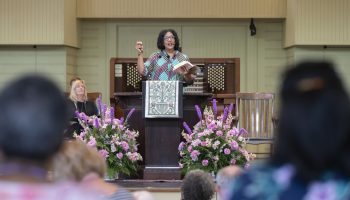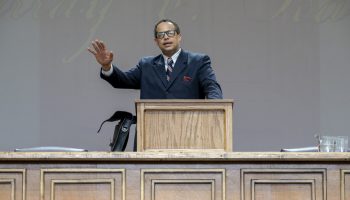We all know the old saw about oil and water not mixing, but both oil and water played vital roles in the origins of what was to become Chautauqua Institution: Oil from the fields of northwestern Pennsylvania generated much of the money that sustained the Chautauqua experiment, and the waters of the lake provided the aesthetic backdrop for the spiritual and culture replenishment that flourished from that experiment.
At 3:30 p.m. Tuesday in Hurlbut Church, Richard Heitzenrater will give a PowerPoint presentation titled “Oil and Water: The First Decade of Chautauqua” as part of the Oliver Archives Heritage Lecture Series.
Heitzenrater, the William Kellon Quick Professor Emeritus of Church History and Wesley Studies at Duke University’s Divinity School, has spent summers at Chautauqua since the 1940s and teaches classes at the Archives Center. Tuesday’s lecture is a distillation of a five-part course, he said.
Before the founding of Chautauqua in 1874 by the Methodist minister John Heyl Vincent and his friend Lewis Miller, a wealthy inventor and businessman, members of the Erie Conference of Methodist Episcopal Churches from western New York, northeastern Ohio and northwestern Pennsylvania began gathering on the shores of the lake at what was then called Fair Point for camp meetings. From 1871 to 1874, they pitched tents in June and August on an area of about 50 acres, which they purchased for $10,000, Heitzenrater said.

0208-03 #21
Much of that money came from the profits of oil drilling in Crawford County, Pennsylvania. In 1859, Edwin L. Drake discovered a significant deposit of crude oil in a creek bed in Titusville, Pennsylvania, about 50 miles south of Chautauqua. The petroleum he found was not used for fuel, like gasoline, in those days, but was lubricating oil that was needed to operate the machines that drove the Industrial Revolution, Heitzenrater said.
Following Drake’s discovery, wildcatters descended on the area and started randomly drilling along creeks trying to replicate Drake’s success.
In 1861, Cyrus D. Angell, a self-taught geologist from Chautauqua County, observed that successful oil wells tended to occur in a pattern irrespective of flowing water. He theorized that oil existed in belts, like underground rivers. By the 1870s, Angell developed a way to maximize oil production by identifying two oil producing areas, drawing a straight line on a map to connect them, then drilling along that line, according to the book Finding Oil: The Nature of Petroleum Geology, 1859-1920 by Brian Frehner. Unlike Drake, who never patented his drilling technology, Angell made a fortune, and he poured a great deal of money into the fledgling Chautauqua Assembly.
“Without oil money, the Chautauqua region’s growth would have been much slower, and likely never would have developed as fully as it did,” wrote Leslie Allen Buhite in her doctoral dissertation, “The Chautauqua Lake Camp Meeting and the Chautauqua Institution” for Florida State University.
The Assembly bought the land for a dollar from the Erie Conference in 1874.
“They had already spent thousands and thousands of dollars improving the place, making repairs and expanding,” Heitzenrater said. “It wasn’t considered a big deal at the time.”
But the other reason the agreement was reached was that Vincent and Miller promised that religious education would remain a defining feature of the community. Within a few years, Chautauqua welcomed other denominations besides the Methodists, the first move toward an ecumenical embrace of diverse religious tradition, which continues Tuesday with the Institution’s focus on interfaith lectures, and the Abrahamic Program for Young Adults, which includes Judaism, Christianity and Islam.
Within a decade, the Chautauqua Lake Sunday School Assembly had become Chautauqua Institution, and broadened its offerings beyond religious interaction to academic subjects, music, art and physical education.
And it continued to grow.
Cottages and boarding houses replaced tents. Steamboats brought visitors from around the country and the world, including President Ulysses S. Grant in 1875. Palestine Park, a physical re-creation of the Holy Land alongside the lake, became an instant attraction with its emphasis on history, geography and religion. A platform was built in what is now Miller Park to hold lectures and concerts, a venue that grew into the Amphitheater in 1879. Wooded areas that were used for spiritual gatherings were developed, with the Hall of Philosophy rising in 1906 in the glade where it remains Tuesday.
Heitzenrater will contrast many images of Chautauqua from then and now in his presentation of the Institution’s early history, which just goes to show that, sometimes, oil and water mix quite nicely.





